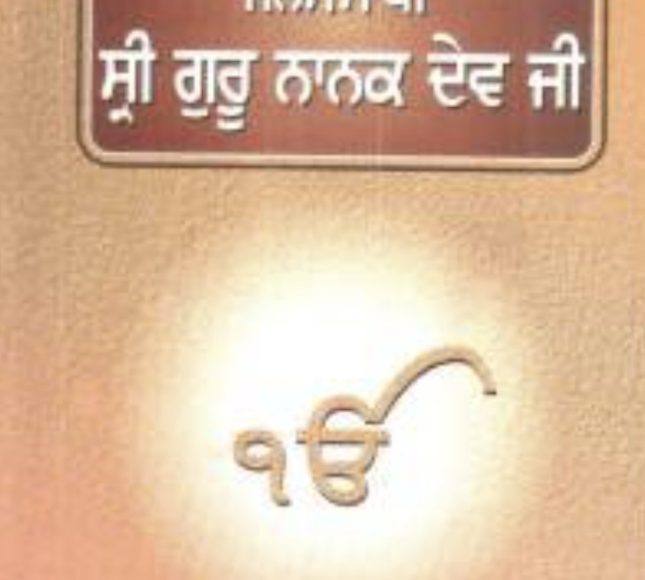CHATURBHUJ POTHI, which forms the third part of what is known as the Miharban Janam Sakhi, is the work of Sodhi Chaturbhuj, the youngest of the three sons of Sodhi Miharban (1581–1639), son of Guru Arjan’s elder brother, Prithi Chand (1558–1618). The only known manuscript of the pothi (book) preserved in the Sikh Historical Research Department of Khalsa College, Amritsar, forms part of a single work divided into three parts—Sachkhand Pothi by Miharban, Pothi Hariji by Miharban’s second son and successor, Hariji (d. 1696), and Chaturbhuj Pothi.
The last one has its name recorded in the colophon as Chatrabhoj Pothi; the author’s name is recorded as Chatar Bhoj, a variation on Chaturbhuj (lit. “with four arms,” as Vishnu is usually shown in images). Chaturbhuj’s pothi contains 74 gostis or discourses and was completed in 1651. It has the same language, style, and format as do the other two pothis—the first by his father and the second by his brother. Each discourse in the pothi commences with a general statement of the situation in which Guru Nanak supposedly delivered it.
Someone poses a question or expresses a doubt pertaining to some religious doctrine or practice, and Guru Nanak proceeds to explain by quoting and expounding one of his hymns. The author, Chaturbhuj in this instance, rounds off the discourse with a sloka, usually a couplet, from Guru Nanak’s bani or of his own composition. The pothi is, as is the Miharban Janam Sakhi as a whole, essentially exegetical rather than biographical, although the opening setting in each gosti does contain references to some specific location and to the person or persons addressed.
The primary concern, however, remains the doctrinal nature of God, nam simran (meditation on the Name), the importance of the true Guru, and so on. While Hari ji chose for his exegesis the longer compositions of Guru Nanak such as Japu, Patth, Sidh Gosti, and Oankar, Chaturbhuj took up, besides chaupadas and astpadis (4-stanza and 8-stanza hymns, respectively), pauris from Vars in Majh and Malhar measures and slokas.
Chaturbhuj Pothi: The Rich Tapestry of Sikh Exegesis
Chaturbhuj Pothi stands as a vital component of early Sikh literature, encapsulated within the broader narrative tradition known as the Miharban Janam Sakhi. This work, which forms the third and final part of that composite chronicle, provides an exegetical insight into the teachings of Guru Nanak rather than offering a strictly biographical account.
Historical and Familial Context
The text is the creation of Sodhi Chaturbhuj—the youngest son of Sodhi Miharban (1581–1639), who himself was the son of Prithi Chand, the elder brother of Guru Arjan. In this way, the lineage of the author is inextricably linked with the early hereditary narratives of the Sikh community. Chaturbhuj Pothi was completed in 1651 and is preserved as the sole known manuscript in the Sikh Historical Research Department at Khalsa College, Amritsar. As such, it not only reflects a family tradition of chronicling Sikh history and spirituality but also occupies a unique place in the evolution of Sikh literature.
Structure and Content
The Chaturbhuj Pothi contains 74 gostis or discourses—each initiated by a brief setting that situates a doctrinal query or doubt in a specific context. Typically, the narrative begins with a description of the circumstances under which Guru Nanak is said to have delivered an explanation on spiritual or religious matters. A question is posed by an interlocutor regarding aspects of divine truth, the nature of God, the practice of nam simran (meditation on the Name), or the importance of following a true Guru. In response, Guru Nanak’s teaching is elucidated by way of quoting one of his own hymns or through an original commentary composed in a similar poetic rhythm.
In crafting these discourses, Chaturbhuj employs a diverse range of poetic styles—bringing in elements such as chaupadas (four-stanza hymns), astpadis (eight-stanza hymns), as well as selections from pauris found in Vars composed in different rhythmic measures (Majh and Malhar). The structure of the Pothi mirrors, in language and format, the other two sections of the Miharban Janam Sakhi (the Sachkhand Pothi by his father and the Pothi Hariji by his brother), yet it stands out for its own distinctive exegetical focus.
The Exegetical Purpose and Doctrinal Emphasis
Unlike purely biographical Janam Sakhis that recount miraculous events and early-life narratives, the Chaturbhuj Pothi is fundamentally an exercise in doctrinal clarification. Its discourses are crafted to explain and expound upon religious teachings—emphasizing concepts such as the nature of the divine, meditation on the eternal Name, and the centrality of the true Guru. Each gosti is prefaced with a contextual setting, followed by a detailed interpretation that links practical spiritual guidance with the poetic cadence of Guru Nanak’s hymns. This method not only makes the complex theological ideas accessible but also enriches the oral and literary tradition of Sikhism with a vibrant, didactic quality.
Legacy and Cultural Significance
Chaturbhuj Pothi significantly contributes to the rich legacy of Sikh historiography by bridging the gap between mystical experience and formal religious instruction. Its exegetical style has influenced later works and remains a subject of scholarly interest among researchers seeking to understand the early interpretative traditions within Sikhism. As part of the Miharban Janam Sakhi, it has helped shape the collective religious consciousness of Sikhs, reinforcing doctrinal principles and preserving the spiritual wisdom that has been passed down through the generations.
In a broader context, the Chaturbhuj Pothi exemplifies how early Sikh literature was not merely about recording events but was also dedicated to exploring and elucidating the inner dimensions of faith. Its legacy endures in the way it continues to inform both the academic study of Sikhism and the lived devotional practices of the community.



